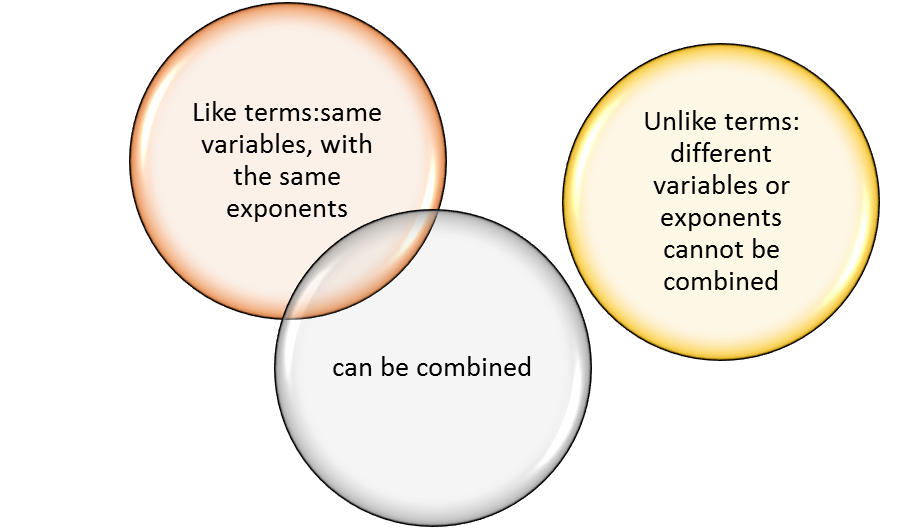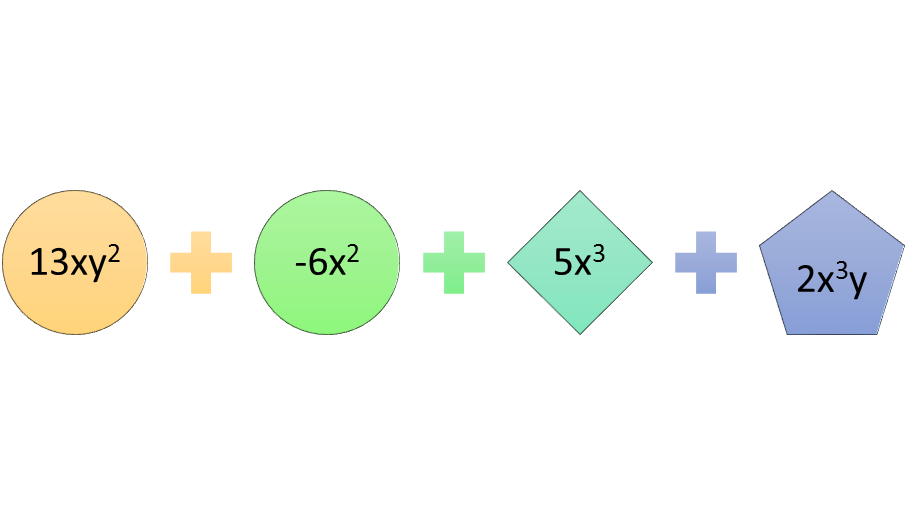Overview
Polynomials with more than one variable are often used in applications when one variable has a relationship with another. Special attention to combining like terms is essential to solving them correctly.
Combining Like Terms
The expressions that contain like terms have exactly the same variables with the same exponents. For example, 3x2y4 can be combined with x2y4. Similarly, 9yz2 can be combined with -2yz2. However, 10xy2 cannot be combined with 5x2y. Although the variables are the same in both monomials, the degrees of the variables are not. Similarly, 8xy cannot be combined with 3yz, because both terms do not have the same variables.
Figure 1: Terms can be combined if they are like terms, but must stand alone if they are unlike terms.
Addition
In order to add polynomials with more than one variable, add all the terms and then combine like terms. Suppose that 5xy2 – 4x2y + 5x3 + 7 is added to 8xy2 – 2x2y + 2x3y + 10. The sum will equal 5xy2 + 8xy2 – 4x2y – 2x2y + 5x3 + 2x3y + 7 + 10. The like terms 5xy2 and 8xy2 can be combined as 13xy2. The like terms -4x2y and -2x2y can be combined as -6x2y, and the like terms 7 + 10 can be combined as 17. The unlike terms 5x3 and 2x3y are part of the sum. The entire sum is 13xy2-6x2y + 5x3 +2x3y + 17.
Figure 2: In the final sum or difference, like terms are combined and unlike terms are separate.
Subtraction
In order to subtract polynomials with more than one variable, the additive inverse of the polynomial is added. This means that every term of the polynomial to be subtracted has an opposite sign. Suppose that the expression is (5x3y2 – 3x2y + 4yz + 8z2 + 9) – (3x3y – x2y + 12z3 + 2z2 – 1). The additive inverse is -3x3y + x2y -12z3 – 2z2 + 1. Combining like terms, -3x2y + x2y is -2x2y, 8z2 – 2z2 is 6z2, and 9 + 1 is 10. There are a number of unlike terms, so the entire difference is 5x3y2-3x3y – 2x2y + 4yz – 12z3 + 6z2 + 10.
Multiplication
Polynomials with more than one variable are multiplied similar to polynomials with one variable, in that every term in one polynomial is multiplied by every term in the other polynomial. Suppose that (6x2y2 + 2x2y + 3xy + 1) is multiplied by (x3y + 2y2). The first term, (6x2y2 + 2x2y + 3xy + 1) (x3y), using the rules of exponents, is 6x5y3 + 2x5y2 + 3x4y2 + x3y. The second term, (6x2y2 + 2x2y + 3xy + 1) (2y2), also using the rules of exponents, is 12x2y4 + 4x2y3 + 6xy3 + 2y2. If there were like terms, they would be combined. The entire product is 6x5y3 + 2x5y2 + 3x4y2 + x3y + 12x2y4 + 4x2y3 + 6xy3 + 2y2.
Figure 3: Every term in one polynomial is multiplied by every term in the other polynomial.
Interested in algebra tutoring services? Learn more about how we are assisting thousands of students each academic year.
SchoolTutoring Academy is the premier educational services company for K-12 and college students. We offer tutoring programs for students in K-12, AP classes, and college. To learn more about how we help parents and students in Golden, CO: visit Tutoring in Golden, CO




